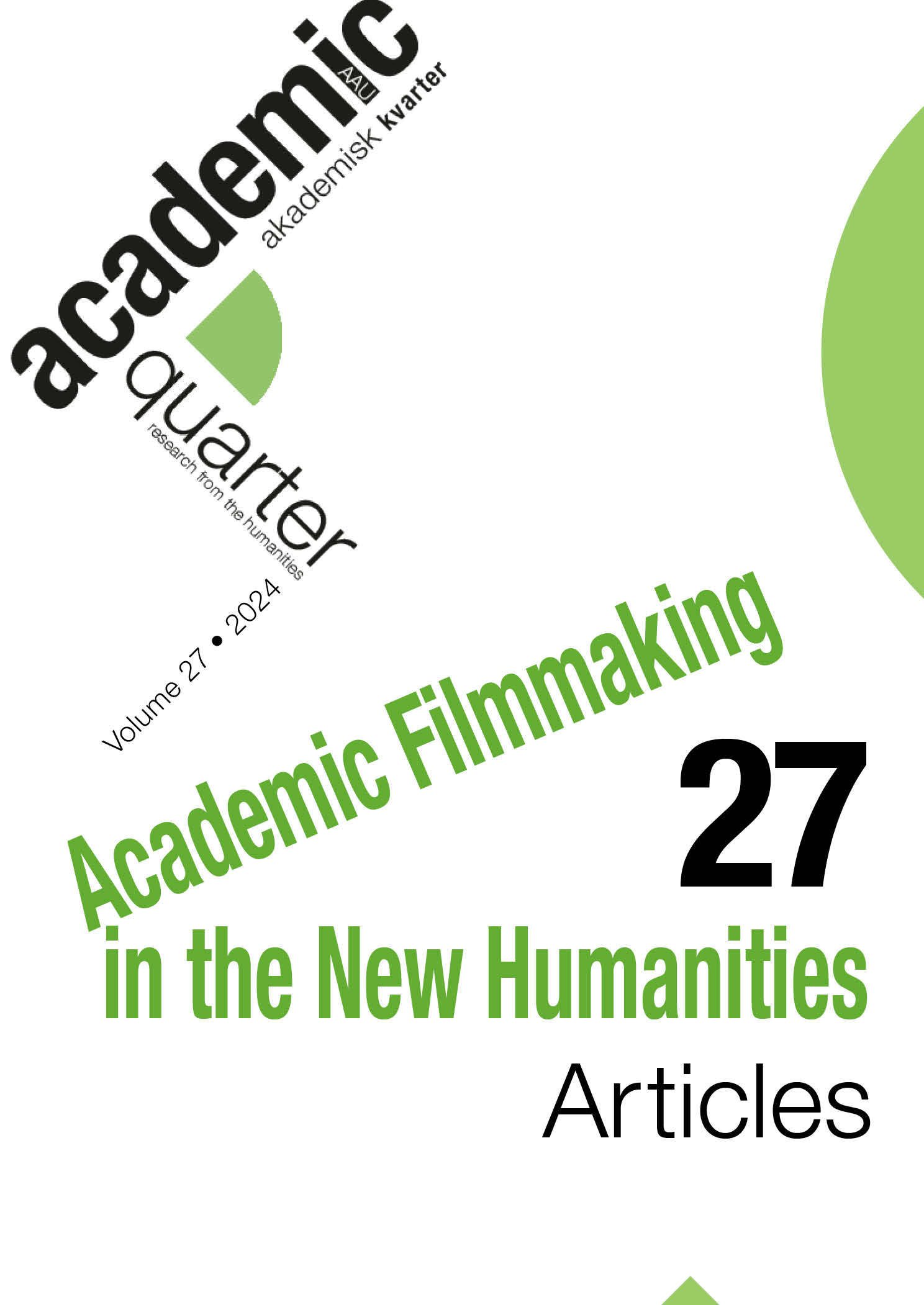Abstract | Abstract
In the process of thinking diegetically, the videographic practitioner is guided by the diegetic (story world) logic of the films or media works under scrutiny. As opposed to videographic approaches that extract audiovisual segments from a narrative and spatiotemporal logic, this form of videographic work engages with the constraints of the source materials’ diegetic tethers to (re)construct a story world in meaningful and productive ways. This essay seeks to explore the ramifications of such diegetic argumentation through an analysis of several videographic works: the author’s “Imagining Orphée | Orphée imaginé” (Oyallon-Koloski 2023), Catherine Grant’s “Fated to be Mated: An Architectural Promenade” (2018), Dayna McLeod’s “Speculative Queer Autoethnography: Desert Hearts” (2023), and Liz Greene’s “Spencer Bell, Nobody Knows My Name” (2022). These examples embrace the intrinsic form of their source material’s diegesis, prioritize the rhetorical impact of spatiotemporal construction, and deliberately balance the pulls between original and videographic diegetic logic through the application of precise videographic techniques. Video essayists use the formal, performative, and nonverbal options afforded by centering diegetic principles in powerful ways to shape their rhetoric.
Referencer
Bordwell, David. 1985. Narration in the Fiction Film. Madison: University of Wisconsin Press.
Deitch, Donna, dir. 1985. Desert Hearts. Desert Hearts Production, The Samuel Goldwyn Company.
Demy, Jacques, dir. 1985. Parking. France 3 Cinéma.
Franceschina, John. 2012. Hermes Pan: The Man Who Danced with Fred Astaire. New York: Oxford University Press. https://doi.org/10.1093/acprof:oso/9780199754298.001.0001
Galibert-Laîné, Chloé. 2019. “Watching The Pain of Others.” [in]Transition: Journal of Film and Moving Image Studies 6 (3). https://doi.org/10.16995/intransition.11428
Godard, Jean-Luc, dir. 1985. Détéctive. Sara Films, JLG Films.
Grant, Catherine. 2014. “The Shudder of a Cinephiliac Idea? Videographic Film Studies Practice as Material Thinking.” ANIKI: Portuguese Journal of the Moving Image 1 (1): 49–62. https://doi.org/10.14591/aniki.v1n1.59
Grant, Catherine. 2016. “The audiovisual essay as performative research.” NECSUS: European Journal of Media Studies (Autumn 2016). http://www.necsus-ejms.org/the-audiovisual-essay-as-performative-research/.
Grant, Catherine. 2018. “Fated to be Mated: An Architectural Promenade.” Video, 04:35. https://vimeo.com/300303270. Accessed 31 August 2023.
Greene, Liz. 2022. “Spencer Bell, Nobody Knows My Name.” Open Screens 5 (1). https://doi.org/10.16995/OS.8160.
Groo, Katherine. 2012. “Cut, Paste, Glitch, and Stutter: Remixing Film History.” Frames Cinema Journal, No. 1 (July 2012). http://framescinemajournal.com/cutpasteglitch.
Keathley, Christian, Jason Mittell, and Catherine Grant, eds. 2019. The Videographic Essay: Practice and Pedagogy. http://videographicessay.org.
Keathley, Christian. 2011. “La Caméra-stylo: Notes on Video Criticism and Cinephilia.” In The Language and Style of Film Criticism, edited by Alex Clayton and Andrew Klevan, 176-191. New York: Routledge.
Kiss, Miklós. 2021. “Desktop documentary: From artefact to artist(ic) emotions.” NECSUS: European Journal of Media Studies (Spring 2021). https://necsus-ejms.org/desktop-documentary-from-artefact-to-artistic-emotions/.
Lee, Kevin B., and Ariel Avissar. 2023. “Desktop documentary as scholarly subjectivity: Five approaches.” NECSUS: European Journal of Media Studies (Spring 2023). https://necsus-ejms.org/desktop-documentary-as-scholarly-subjectivity-five-approaches/.
Lee, Kevin B. 2014. “Talking with Siri About Spike Jonze’s Her.” Video, 09:31. https://vimeo.com/86838912. Accessed 12 February 2024.
Mamoulian, Rouben, dir. 1957. Silk Stockings. Beverly Hills, CA: MGM.
McLeod, Dayna. 2022. “s/mother love/r.” Video, 07:17 mins. https://daynarama.com/s-mother-love-r/. Accessed 12 February 2024.
McLeod, Dayna. 2023. “Speculative Queer Autoethnography: Desert Hearts.” https://daynarama.com/speculative-queer-autoethnography-desert-hearts/. Accessed 31 August 2023.
Mittell, Jason. 2016. “Adaptation’s Anomalies.” [in]Transition: Journal of Film and Moving Image Studies 3 (1). https://doi.org/10.16995/intransition.11325
Mittell, Jason. 2021. “Deformin’ in the Rain: How (and Why) to Break a Classic Film.” Digital Humanities Quarterly 15 (1). https://www.digitalhumanities.org/dhq/vol/15/1/000521/000521.html.
Mittell, Jason. 2019. “Videographic Criticism as a Digital Humanities Method.” In Debates in the Digital Humanities 2019, edited by Matthew K. Gold and Lauren F. Klein, 224-242. Minneapolis: University of Minnesota Press. https://doi.org/10.5749/j.ctvg251hk.23
Morgan, Daniel. 2021. The Lure of the Image: Epistemic Fantasies of the Moving Camera. Oakland: University of California Press. https://doi.org/10.1525/9780520975446
O’Leary, Alan. 2021. “Workshop of Potential Scholarship: Manifesto for a Parametric Videographic Criticism.” NECSUS: European Journal of Media Studies (Spring 2021). https://necsus-ejms.org/workshop-of-potential-scholarship-manifesto-for-a-parametric-videographic-criticism/.
Oyallon-Koloski, Jenny. 2023. “Imagining Orphée | Orphée imaginé.” Video, 10:00. https://vimeo.com/cinemajok/orpheus. Accessed 12 February 2024.
Semon, Larry, dir. 1925. The Wizard of Oz. Chadwick Pictures Corporation.
Spatz, Ben. 2018. “The video way of thinking.” South African Theatre Journal 31 (1):146-154. https://doi.org/10.1080/10137548.2017.1414629.

Dette værk er under følgende licens Creative Commons Navngivelse – Ikke-kommerciel – Ingen Bearbejdede Værker (by-nc-nd).
Copyright (c) 2024 Jenny Oyallon-Koloski
